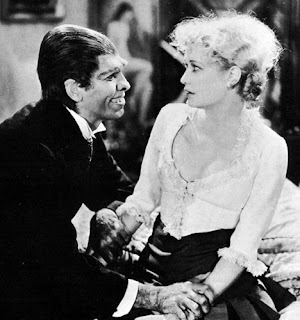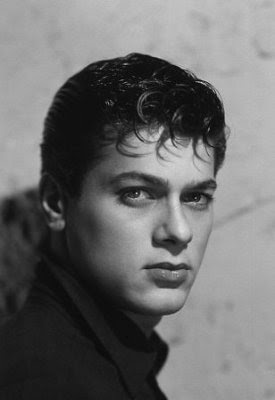The go-getter in Tony Curtis was always looking for the next project. When he heard about a film being produced by a particular director with whom he wanted to work, or when he was very intrigued by a particular character, he had no qualms about contacting whoever was involved to add his name to the list of "Maybes." Even after he had established himself as a bankable star, he wasn't guaranteed every part he wanted. He still had to schmooze, ingratiate himself with the right people, and work to stay on top. From time to time, his efforts would be in vain. For example, when Tony heard that Blake Edwards was going to be shooting Breakfast at Tiffany's (1961), he thought he would be perfect for the male lead. The fact that he was good friends with Blake also made him assume that he would have a little extra pull in the casting office. However, things didn't pan out, and the role went instead to George Peppard (above with Audrey on the set). Makes ya wonder... Tony was fine with the rebuff-- it was the business after all-- but he would remark that Blake spoke to him less frequently after this unfortunate exchange, as if embarrassed that he had let his friend down. Tony recalled a palpable awkwardness on the later set of their collaboration, The Great Race.
Interestingly, this wasn't the only Audrey Hepburn picture that Tony hoped to star in. He would also push for the role of Audrey's cross-country love interest in 1967's Two for the Road. Audrey seemed up for the idea, but it turns out that it was her husband at the time, Mel Ferrer, who thought the casting wasn't right. If he was threatened by the handsome Tony's reputation with the ladies, he needn't have been. Tony and Audrey never had anything but a respectful friendship. In fact, had Tony starred in the role of Mark Wallace, history may have turned out a bit differently... As well as Audrey's marriage. For it was Albert Finney, (pictured left on the set with Audrey) the rugged, British actor that would wind up snagging the role and engaging in a heated affair with the graceful and alluring gamin. (Whoops, Mel). Tony was a long shot for this one anyway, since the role had already been offered to Michael Caine and Paul Newman.
Again, Tony shed no tears. He had at least been able to enjoy sharing the screen with the delightful Audrey in his brief but memorable appearance in the classic Paris, When It Sizzles of 1964. Tony's role in the fantasy sequence where Audrey is approached by a potential love interest, on a moped no less, was an uncredited favor Tony did for director Richard Quine. Quine needed to buy some time on the set, due to the fact that the film's male lead, William Holden (with whom Audrey had earlier had an alleged, tumultuous affair on the set of Sabrina), was coming down from one of his benders and needed time to recuperate and rehabilitate before filming could resume. So, Quine added a little scene that would give Audrey another actor to perform with in William's absence, and his pal Tony honorably entered to save the day. The moment is memorable and made all the more perfectly absurd due to Tony's presence, which was completely in keeping with the tone of the film.
Tony relaxes on the set with Audrey.
Just as Tony was surreptitiously intercepted from the lovely Ms. Hepburn, Grace Kelly would likewise be "plot-blocked" from James Dean, and both times by Elizabeth Taylor! Don't get excited, no cat-fights were involved. The two instances in which Grace was offered a role that later went to Liz were the results of timing, not conniving. The first example occurred when Grace was offered the lead in Giant (1956). Grace (right in High Noon) was intrigued by the role in the film, but MGM wanted to put her in The Bottom of the Bottle at her home studio instead of loaning her out to George Stevens at Warner Bros. Grace balked, refused to take on the role in the Metro vehicle, and as a result was put on suspension. She was not a woman apt to be told what to do. So, while Grace enjoyed some well-deserved time off, mocking the studio's ineffective punishment, Liz snatched up the role in Giant and subsequently ran away with it. It was a fated situation, for on the set Liz would become incredibly close with both her male co-stars, the tragic Dean-- with whom she built an understanding and closeness that few others on the set could accomplish-- and more importantly, Rock Hudson. Their friendship was lifelong, and it was Rock's later lost battle with AIDS that would launch Liz's steadfast activism toward finding a cure for the disease. She remains passionate about the cause to this day.
The final casting coup: Liz, Rock, and Jimmy
Item #2 was ill-fated from the get-go. The original cast of Cat on a Hot Tin Roof was to include James Dean and Grace Kelly-- and supposedly, Orson Welles as Big Daddy. The film had been in the works for several years, so by the time Richard Brooks finally got behind the camera to shoot the Tennessee Williams masterpiece, which was postponed until it ended its Broadway run on the stage, the original game pieces had already changed. Grace was married and living in Monaco, James had shockingly already died, and Orson was off being Orson somewhere. So, Liz stepped in opposite Paul Newman. I think we can all agree that this version of Maggie the Cat made the aforementioned 'Roof' much, much hotter! Though Grace's legendary use of restraint would have worked well in indicating the simmering, lustful boil beneath the beautiful surface of Maggie's character, Liz was far more openly sexual (feast your eyes, left). Grace was a sensual woman, equally capable of displaying eroticism, but her cries for sexual mercy would not have provided the carnal howl that Liz was able to produce. When she screams, "Maggie the cat is alive!" you know she means it, and you fear the fangs! (Well, maybe the guys don't). In the James vs. Paul category, it is hard to say who would have proved a better haunted and drunken golden boy. Paul had a few years on Jimmy, so his maturity certainly added to his understanding of the character. He is so perfect in the role that it is hard to imagine even the incomparable Dean showing him up. It also turned out that Burl Ives, (now best remembered for his renditions of Christmas songs), would play Big Daddy instead of Orson. Paul had fortunately already gotten to work opposite the eccentric master Welles when they co-starred in The Long Hot Summer earlier that year.
The true testament of sex appeal: when it still works on crutches



























